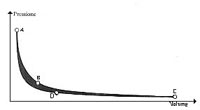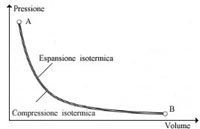The theoretical Carnot engine


Theoretical Carnot cicle.

Atkins cicle.
To understand this engine you will have to follow the gas pressures variations inside the cylinder.
If the piston goes in the cylinder the gas pressure raises and his volume decreases.
The pressure increase depends on the compression circumstances: if the cylinder can transfer heat to outer the gas temperature in compression can't increase. The curve to represents this condition is a isotermic curve. If the cylinder is insulated, the gas during the compression increases, in addition to the pressure, also his temperature. The curve that represents this transformation is named adiabatic curve.
The cicle begins from the point A. The piston is completely inserted in the cylinder which is in contact with the hot source.
The volume of gas is the lowest and his pressure is the highest as his temperature.
The hight pressure pushes back the piston and the engine generates power. From the point A to the point B the curve must be isotermic and, because a gas in expansion cools down, is necessary to maintain the cylinder in conctact with the heat source at hight temperature.
While the engine generates power demands heat.
In the Atkins cicle (please see figure) from the point B the piston is brought back to the point A by the crankshaft rotation .
If the compression is isotermic the gas will become at the initial state following a curve like that of expansion. This cicle is a useless cicle because all the work generated by the expansion is expended to carry back the piston and the gas at the initials conditions.
So that the cicle becomes useful the compression stroke must use less work than that produced by the expansion stroke. This result is obtained by an adiabatic compression. When the piston reachs the point B (Carnot cicle) the source of heat must be separated from the cylinder. From the point B to the point C a work is still generated but without dissipate heat. The curve from B to C is an adiabatic.
From C to D the cylinder is in contact with the cold source (to reduce the pressure). The gas dont warm up because the heat, generated by the compression, is transferred to the cold source (in contact with the cylinder). From C to D the curve is an isotermic curve. From D to A the gas must warm up and the cold source must be separated from the cylinder. From D to A the curve is an adiabatic curve.
Now the expansion stroke has generated more power than that used by the compression stroke. As provided by second law of Thermodynamics, without the cold source isn't possible to generate power.
The second law of Thermodynamics says just that isn't possible to transform all the heat in work, is necessary to lose a part of it.